This is the best bread made with wild mushrooms I've ever made. If you're a mushroom hunter who also makes sourdough, or just want a loaf that actually tastes like mushrooms, you're in the right place.
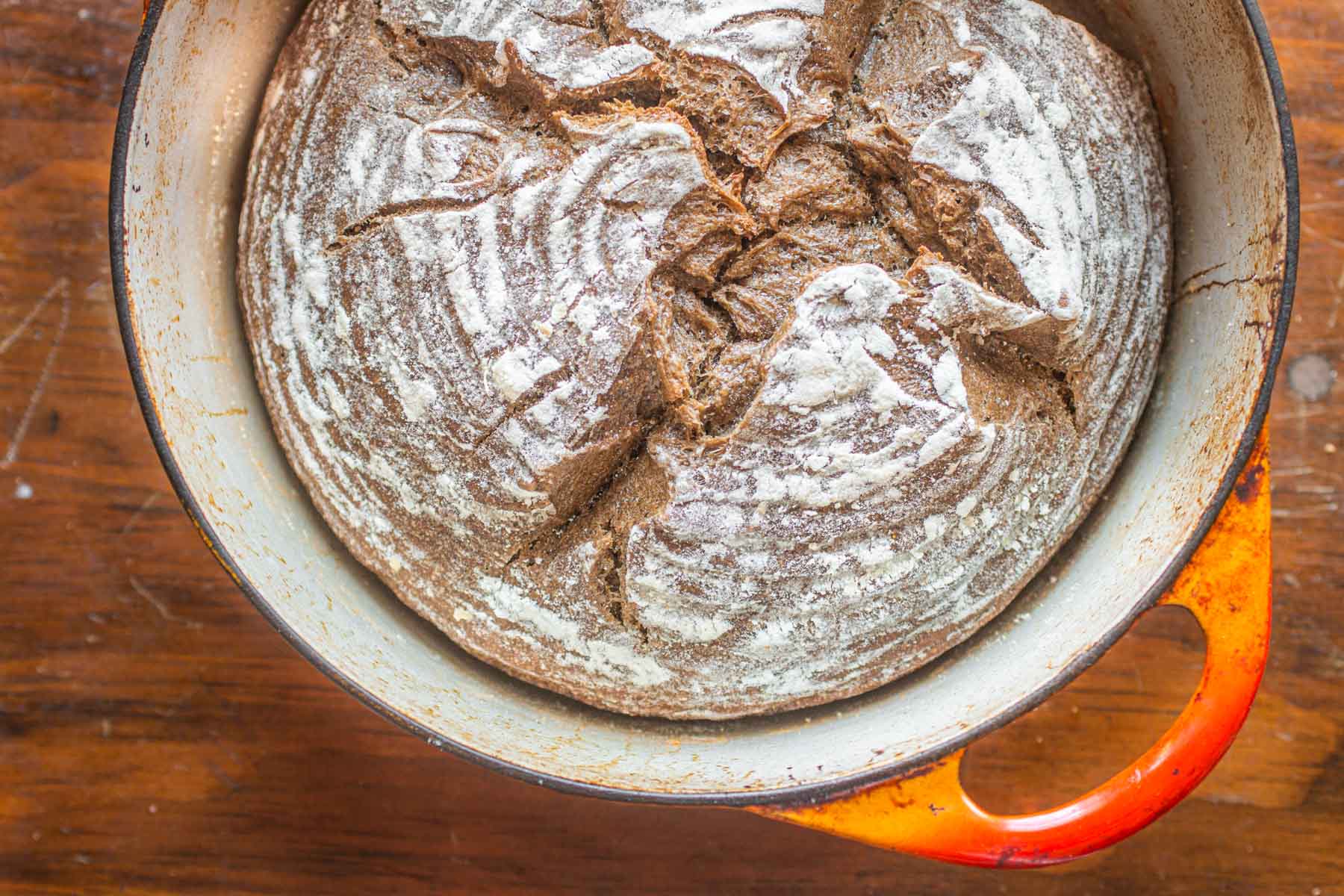
When I first started to be interested in mushrooms I remember reading somewhere that pioneers, out of desperation, would make a sort of bread from puffballs. Ever since then, I've wanted to make, or just taste, bread made with wild mushrooms. There was only problem: I had no idea how to make bread.
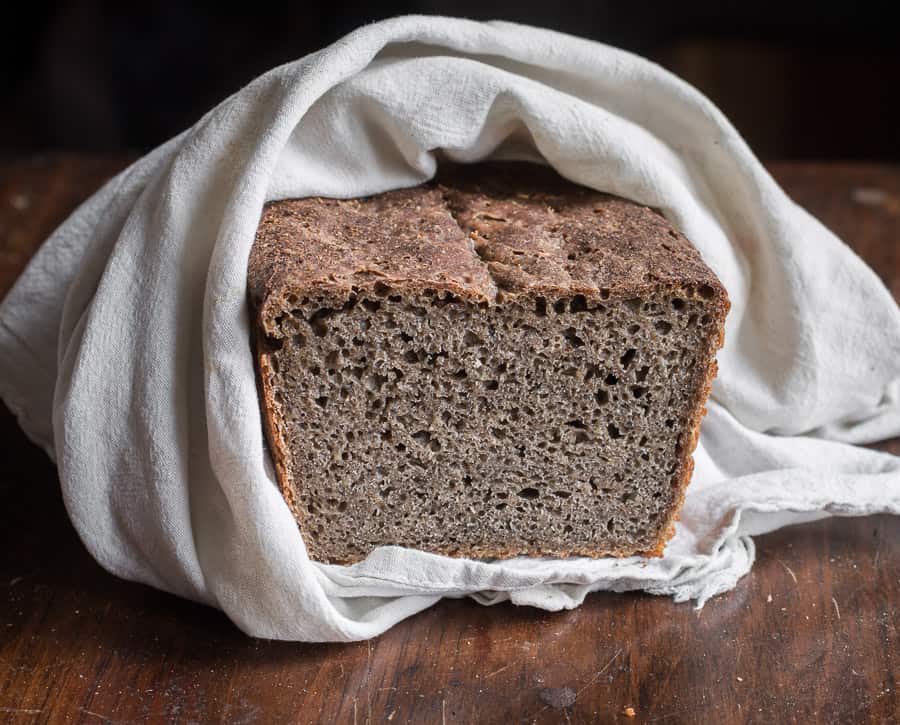
As fate would have it, as the last restaurant I worked at was closing I ended up playing baker, pastry chef, prep cook, pantry and expo, which was as fun as it sounds. After everything was said and done, baking became a sort of therapy for me, it was something I could study, fail at, and lose myself in.
Little by little I made headway, but of course I made things more difficult by trying to start baking with all natural sourdough starters and only whole, heritage grains instead of using commercial yeast and much more forgiving bread flour. Unless you have a solid anger management program, I don't suggest you start like that.
After I made a few solid loaves, I knew it was time to try and start developing a formula for the mushroom bread I'd thought of so long ago. It ended up being another rabbit hole, and much more complicated than I expected.
Baking with mushroom flour/powder
My first instinct was to make bread using dried mushroom flour/powder. I would make the dough and just incorporate the powder in as I went, like a normal dough. There was a problem though, I was making loaves one at a time, since dried mushrooms are expensive/labor intensive to harvest.
After a few loaves, I saw that I could easily burn through pounds of dried mushrooms in just a few tries using mushroom powder, which could get to be a pretty expensive experiment. Luckily in that area I'm a bit like Smaug the dragon, hoarding mushrooms instead of gold.
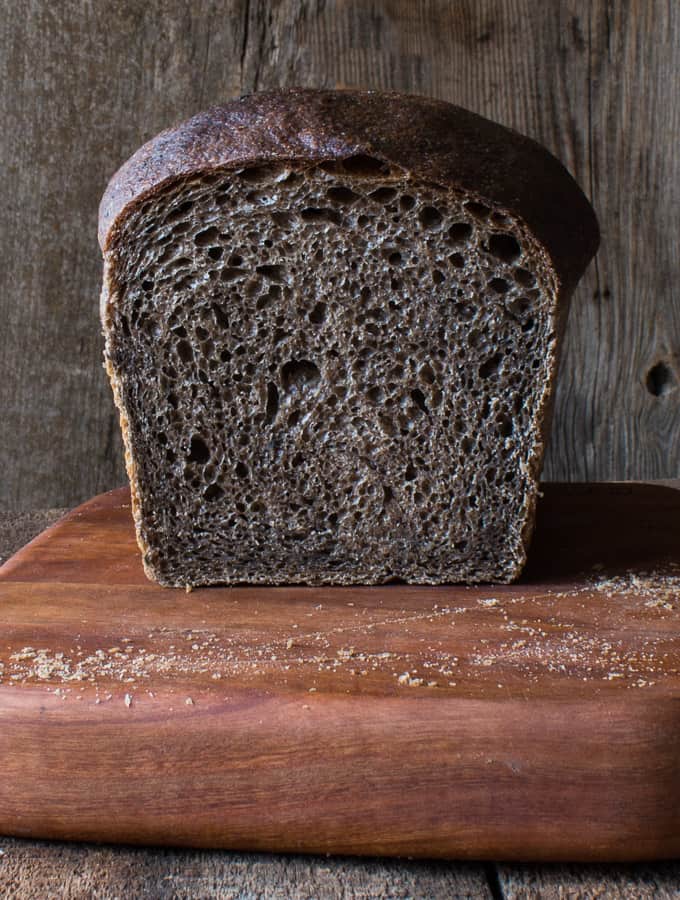
The first loaves just weren't mushroomy enough, so I started to add more mushroom flour. The more powdered mushrooms I added, the stranger the loaves got, up until the point where I was adding about ¼ lb of dried mushrooms to a loaf.
They bread sure looked mushroomy, but the flavor was, well, nothing special, I might as well have added some dark rye flour. I wanted a loaf that actually tasted like mushrooms, and it was maddening to me that increasing the proportion of mushrooms in the dough didn't seem to have much of an effect on the flavor.
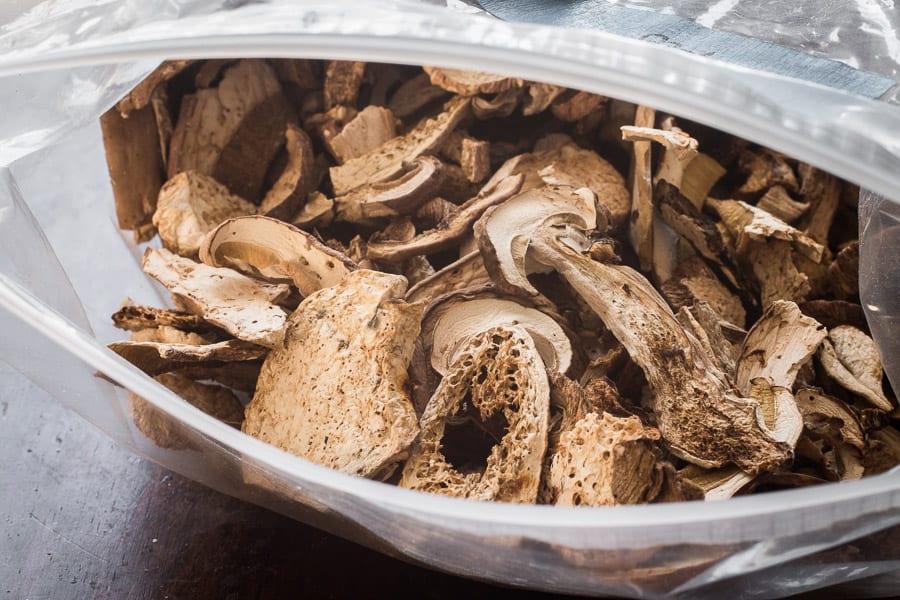
Then I had a eureka moment, I knew why the flavor wasn't coming through: I wasn't activating it. Mushroom powder by itself doesn't taste like much, it's flavor blooms when it's exposed to heat, or moisture. Or both.
With mushroom powder, this generally happens in the process of re-hydrating, or when something crusted with dried mushrooms is exposed to heat and fat, like when you crust a steak, piece of fish, etc.
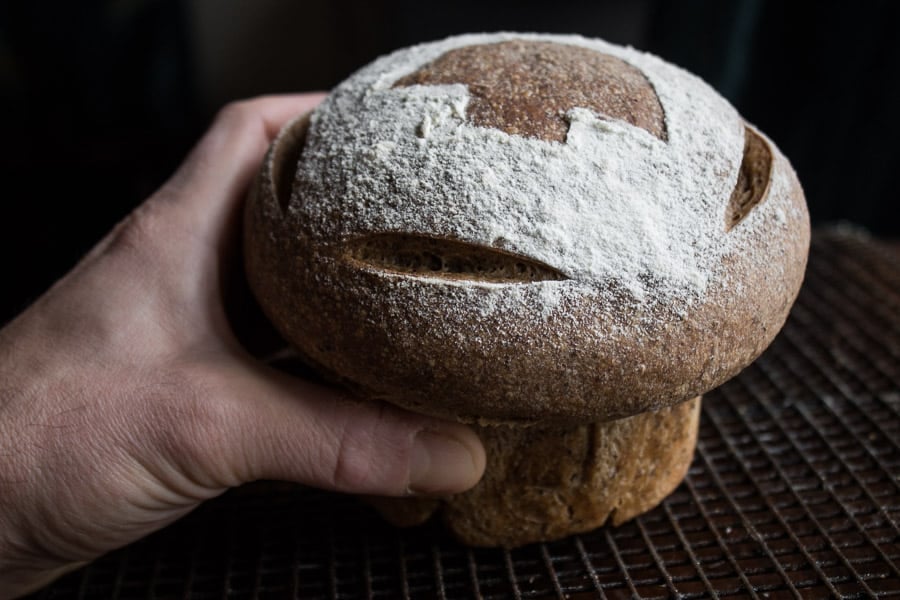
The key: adding mushroom puree to the dough
Incorporating the theory into a loaf of bread is no different. What I did was start out with whole mushrooms instead of powder, then I took a proportion of the water out of the final dough formula and added it to the mushrooms, cooked them together, then made it into a puree that gets folded into the dough.
When the first loaf with the new technique came out of the oven I knew I was onto something, the color was darker, and the smell was rich and earthy, just what I imagined.
I about squealed when I cut into the first loaf, it wasn't dark like a rye, as my other loaves were, it was something new: jet black, darker than the deepest Russian rye I'd ever seen. What was even better was that it tasted good, without a trace of bitterness I thought might happen as a byproduct of using dried mushrooms.
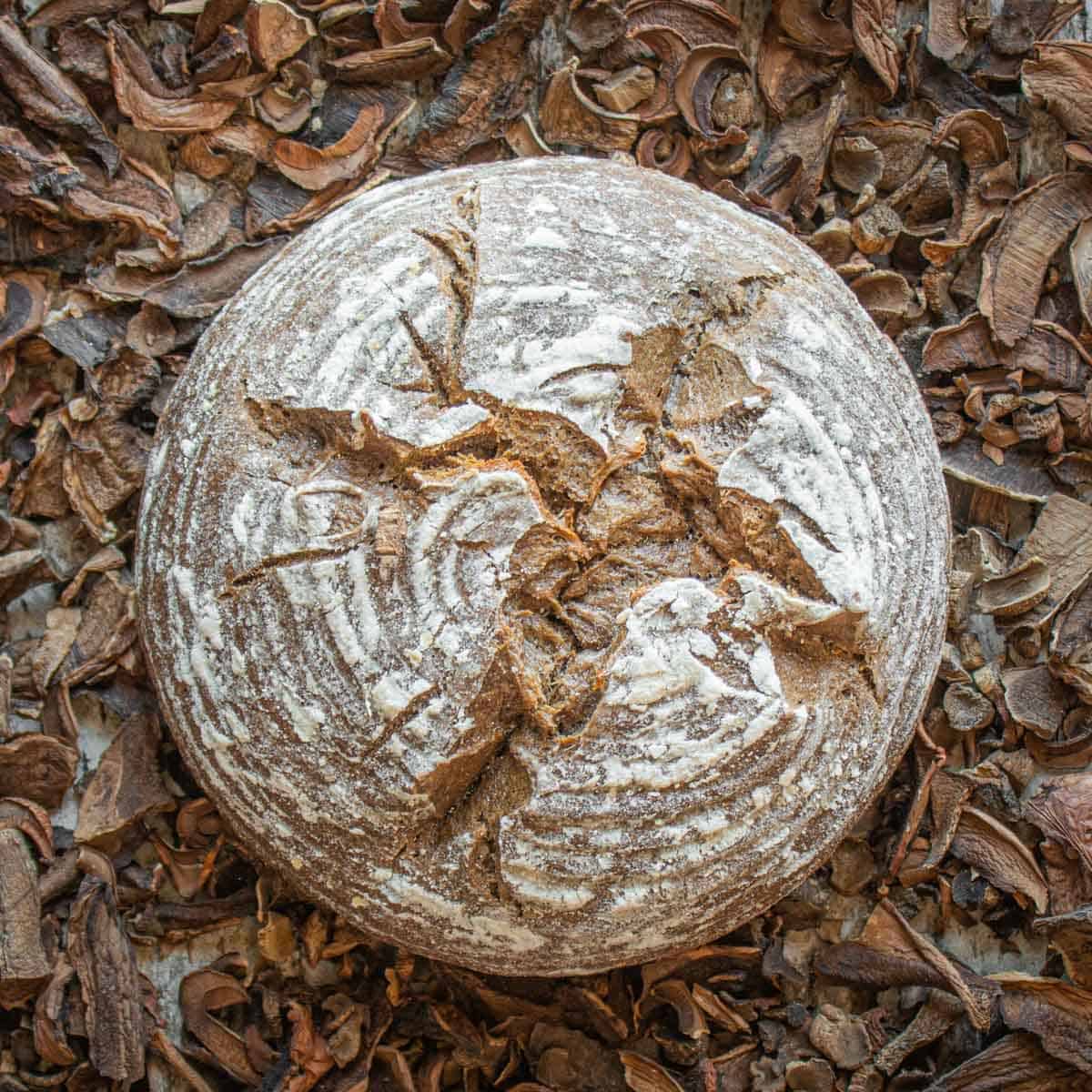
Making one loaf wasn't enough though. Every mushroom is unique, and I could see, even baking with the mushroom powders that different species created different flavors and following that, combinations of species created hybrid flavors. I needed to know how to manipulate the flavors and as you might expect, It all has to do with what species you bake with. Here's what I found:
Manipulating flavors by using different species
Dried mushrooms that gave the deepest flavor were those that give off more dark, rich, liquid when re-hydrated. From my experience, these were, but shouldn't be limited to most species of boletes, agaricus, black trumpet mushrooms and parasols I found with all of those, the darker the liquid the mushroom species gave after re-hydrating, the more I liked the outcome.
I can't stress enough how nuanced each species was, and if you're wondering, I definitely found a favorite: birch and aspen boletes, with slippery jacks coming in a close second. Needless to say, I thought it was a pretty novel way to use mushrooms a lot of people pass up.
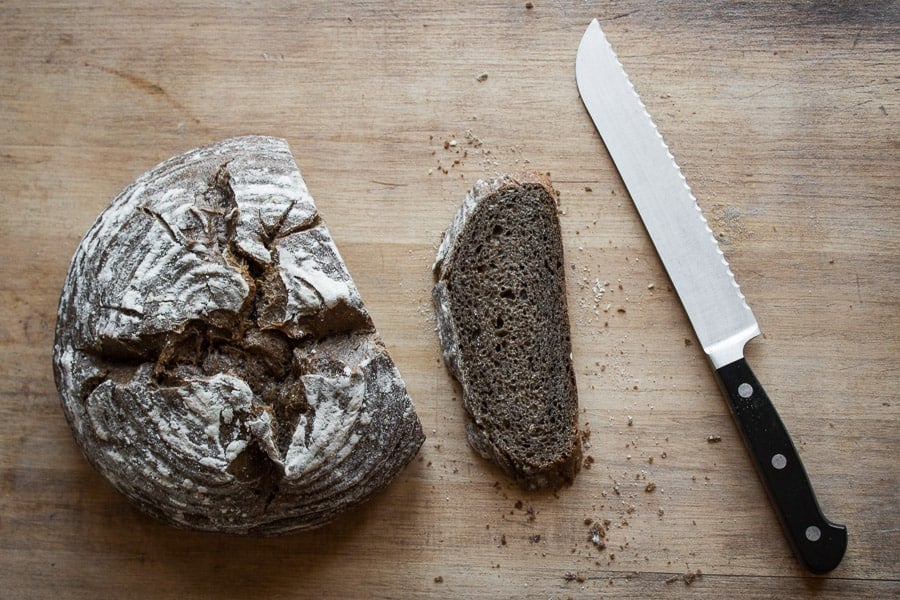
Mushrooms I thought had mediocre flavor were those that gave lighter colored liquid when re-hydrated. After I saw a trend, I started baking strictly with darker colored mushrooms, but Hygrophorus russula, pretty much all Lactifluus and lobster mushrooms didn't really do much for me.
Baking bread in a dutch oven?
This is optional, but gives a dramatic oven spring since the bread steams from it's own moisture to help it rise, it's my go to for baking loaves at home. A cast iron dutch oven holds heat very well, and is the closest thing to having a wood fired, super hot hearth in your home. Once you try it you'll never go back, guaranteed.
Now, as for the actual baking, there's two different ways I'll share to make this, one method uses a sourdough starter made from equal weight of flour and water feedings (also known as 1:1:1), and the other uses commercial yeast.
I recommend using a scale to weigh the ingredients, it's much easier. Either method may give you the most interesting way to blow through those dried boletes yet before the 2018 season comes, and it's a great way to heat up the house in the winter if you live in the north, like I do.
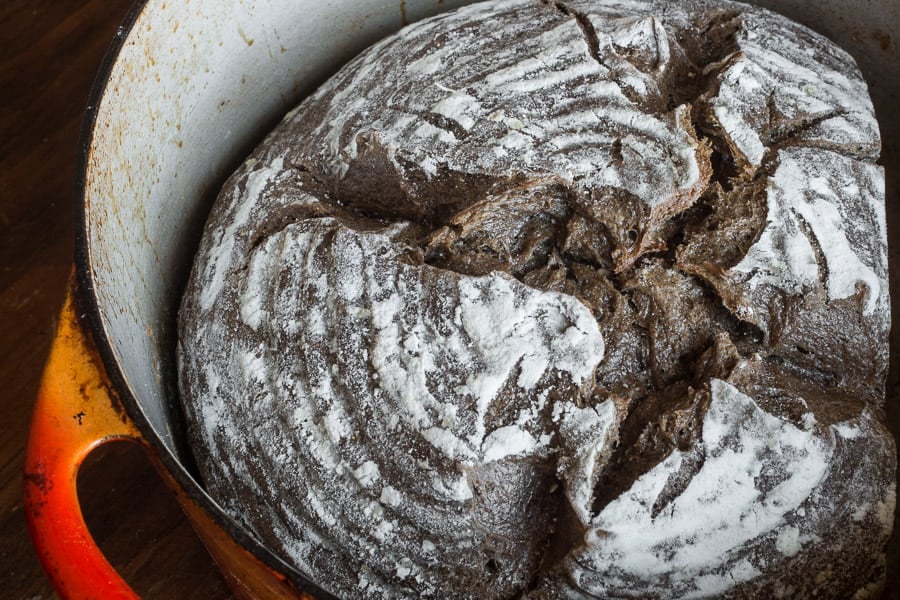
Wild Mushroom Sourdough
Equipment
- 1 Stand mixer
- 1 Banneton basket optional
Ingredients
Pre-fermented sponge:
- 120 grams ~½ cup 1:1:1 hydration starter, fed and active This is 60 grams water and 60 grams flour
- 120 grams ~½ cup warm water
- 120 grams ~1 cup whole wheat flour
Final Dough
- 60 grams ~⅓ cup diced yellow onion
- 300 grams ~2.5 cups all purpose flour or high gluten bread flour
- 240 grams ~1 cup warm water
- 40 grams (1.5 oz) dried wild mushrooms preferably a type of boletus, like Leccinum or Suillus. This is roughly equal to 2.25 cups of sliced, dried mushrooms, not crumbled.
- 50 grams melted lard ¼ cup or a flavorful oil, like sunflower or olive oil
- 1.5 teaspoons fine sea salt or finely ground kosher salt
- 1 teaspoon Instant yeast Optional, use this if you want to omit the sourdough starter, or want the bread to rise quicker.
Instructions
- Combine the ingredients for the preferment, stir well, and allow to rise overnight. Rehydrate the mushrooms in the 220 grams of water and allow to rehydrate, then stir them to remove any grit, remove the mushrooms and rough chop, strain the liquid, then reserve both separately.
- The next morning, sweat the onion in a tablespoon of the oil until translucent, then add the mushrooms and cook on low-medium heat for 5 minutes, allow to cool until just warm, then puree in a blender until very fine with the remaining lard or oil, and the mushroom liquid, cool the puree to room temperature, or use a thermometer and make the dough when it comes to 90F.
- Combine the sponge and all the ingredients for the final dough including the yeast if using, but reserve the salt. Mix together in a bowl just until the flour is hydrated, (or use a stand mixer with the paddle for a minute or two). Allow the mixture to rest for 15 minutes before you add the salt (this is called autolyse).
- Add the salt, then remove the dough and knead on a floured surface for a few minutes until it springs back when poked and the salt is distributed. Form the dough into a ball, then put in an oiled bowl or container and allow to rise, covered until 2.5 times it’s original size, which should take a couple hours depending on the warmth of your kitchen.
- Fold the dough over itself a few times during the rising process.
- When the dough has finished the first rise, remove it gently to a lightly floured board and shape it into a loaf, trying not to release too much of the gas and deflate it while handling. Put the dough into a lightly oiled pan, then cover with plastic and allow to rise again until doubled in size. You can also put the bread in the fridge at this point, covered, overnight, and bake it directly from the fridge in the a.m., which is a great way to make it work with a schedule.
- Remove the plastic, then put a lidded dutch oven in the oven and pre-heat to 450 and bake for 30-45 minutes, removing the lid on the dutch oven after 20 minutes until a thermometer reads 190F in the middle. If the loaf looks like it needs more color on the crust, blast it for a few minutes with higher heat.
- Remove the loaf from the oven, carefully take it out of it’s pan and cool on a rack. Wait until it’s cool until slicing, or better yet, a day or two. Serve the bread toasted.

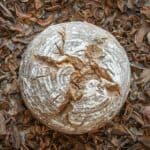
Anastasia Jacklitch
I have a bag of dried wood ears that I bought from a market a while back and have not yet been inspired to use them in any dish. I was originally thinking soup, but am wondering if reconstituted and pured they would add good flavor to bread, being that the stock is so dark. Have you tried this, any suggestion on whether this would be a good use or should I stick to using them in soup?
Alan Bergo
Hi Anastasia. Personally I would use them in soup as their flavor is very mild.
Matt Bolton
So no strength building folds or coil folds with the dough? I just came across this recipe and have access to many of the mushrooms although I will dehydrate them myself so I’m going to try it. Just curious about that before I start.
And I’ve been thinking about some kind of mushroom bread since reading Bourdains Kitchen Confidential about 15 years ago and Adam, no last name known, was making a mushroom starter. Funny how that one line in a book has had me craving for years. Good post and thank you.
Alan Bergo
Thanks Matt. I do some structure folds and had neglected to put that in. Thanks for the reminder.
Marjorie Jackson
Just came across your website and this recipe. I don't know how I missed seeing either of them before!! Thank you for all your research. I was looking for the conventional yeast method you mention you would include and cannot seem to find it discussed. Could you explain further, please? Thank you.
Alan Bergo
Thanks Marjorie, looks like the amount of instant yeast got clipped in an editing or formatting snafoo. I replaced it and added notes about the flour proportions you can follow in the recipe notes. Let me know if it works out for you or if I can help you trouble shoot anything else.
Richard Dietzel
There are two sentence fragments that are not entirely clear these are not major but the novice baker may be confused.
"sweat the onion in a tablespoon of the oil until translucent, then remove the mushrooms add the mushrooms, clarify the remove from where.
Then, "removing the lid on the dutch oven after 20 minutes in case your oven until a thermometer reads 190F in the middle.", "In case" what?
I will be using what a desert city dweller has available to him and I believe it will be a revelation.
Alan Bergo
Thanks Richard. I edit things regularly for copy and clarity as needed, sometimes I get internet hiccups, etc, and things can get clipped or abridged by accident. I adjusted those, thanks for the copy edit!
Pushpalatha Jogottu
Wonderful! I appreciate your effort, inspired by you I am gonna prepare fresh mushroom bread as we cultivate it in our unit in Bangalore, India
Alan Bergo
Excellent. If you can, send me a picture or two! alanbergo3@gmail.com --Alan
Pushpalatha Jogottu
Definitely Mr.Alan now you have to advise me blanched fresh oyster’s purée can be tried ? Instead of dried one
Alan Bergo
I wouldn't blanch it, cook it down and caramelize it, then puree and add it to the dough.
Hayley
I wanted to point out that in the sponge you have 120g=1/2c water ....that gave you a hydration of 87%!!! I think you meant 113g?
Alan Bergo
I'm assuming you're doing basic hydration math here. Remember that the mushrooms are cooked and made into a puree which removes some water.
Jenny
Fresh vs dried .... have several pounds of fresh chanterelles. Could I incorporate those into sourdough with say a mild gruyere cheese?
Alan Bergo
Sure, but it would be a waste IMO if you're trying to get the bread to taste like chanterelles. Foccacia topped with gruyere is a good place to use freshly cooked chants. I used to sell it in the deli attached to one of my restaurants--think focaccia flatbread. This recipe is all about using dried, rich tasting mushrooms like boletes or trumpets, and having the bread taste of them. If you dry some chanterelles, the powder does make a nice addition to breads, pancakes, etc, used in heavy quantity.
Mark S
Wow!
What a stellar recipe.
I used morels and black truffle oil (1/4cup), the entire house smelled of truffles for days, hahaha.
The bread turned out really well.
Thanks so much for this recipe and this site.
Alan Bergo
Hey Mark, thanks so much. I spent months working on this one. The smell of the bread baking, as you got to witness, is something to behold.
Elizabeth Sallee Bauer
Ha! As I was contemplating what kind of sourdough to make today my eyes fell upon my jars of dried black trumpets. I randomly googled "wild mushroom sourdough" and of course you came right up:) It seems like you've tried everything I want to do! My initial thought was just reconstituting the shrooms and using the liquid for the water in my dough and folding in the chopped up trumpets. I'm a bit worried about bitterness though. Does the cooking a pureeing seem to help with that? I was also thinking of adding some chopped fermented chives to add a pop of brightness.
Alan Bergo
As I describe in the post here, just adding mushroom liquid or chopped mushrooms will add little to no perceptible flavor. Trumpets are fine, and I wouldn't worry too much about bitterness, but don't use a ton of old starter, etc. Since trumpets have a light volume, I would add some cooked down, browned cultivated mushrooms to the trumpets to make the amount puree called for relative to the amount of dough you're making. Alan.
Laura
Five teaspoon salt??? Really?
Alan Bergo
Thanks for your eye there. it's 1.5 teaspoons.
Sabine Walter
This sounds really cool! I'm working on a sourdough bread today and, after reading this, decided to add some mushroom powder (well, ground up, home-dehydrated mushrooms) to my cooked freekeh, which I'll add as an inclusion. I don't have any of the fancy mushrooms, just what I can get in the store, but even the baby portobellos increase in flavor tremendously after being dehydrated. Question to you: have you tried to add mushroom powder to the outside of the bread to enhance the flavor of the crust? Just one of those crazy ideas I come up with. Since I usually coat my banneton with rice flour, why not use "mushroom" flour instead?
Alan Bergo
Yes I've added it to the outside and it was fine-I used lobster mushrooms and I was making brioche buns. As I mention in the article for the best flavor dried mushrooms should be reconstituted, cooked and pureed for adding to dough.
Su
I am wondering why you say “not porcini”. Is the flavor too strong?
Alan Bergo
No, It's fine to use them if you want, you just won't get the same color in the pictures here.
Su
Thanks Alan for the recipe. The bread turns out great! Not as brown but very good flavor. I added some fresh mushroom as well for texture.
Alan Bergo
Great to hear you added some fresh mushies in there, I'd been wondering how that might work. Thanks Su.
Louise Lecouffe
This is wonderful! I thoroughly enjoyed hearing about your process and how you came to appreciate the overlooked dark mushrooms. Our favourite fermented (just salt +spices) mushrooms are lobster, pine/matsutake, white chanterelle, winter chanterelle etc and the dark brown mushrooms you speak of don't lend we'll to our style of fermenting - but! Im please to hear how they can be fermented with bread. I bet gypsy mushroom bread would be Devine! Thank you for contributing to the knowledge base. Cheers!
Rodger K. HAmilton
I tried to make pizza dough with powdered hen-of-the-woods and the dough turned into a sort of primordial goo - it wouldn't even shape! I think the yeast and the maitake disagreed. I baked it anyway, given the value of the powder. It was the texture of very bad corn bread! We ate it anyway.
Thanks for seeing it through to good food! I will try again...
Rodger